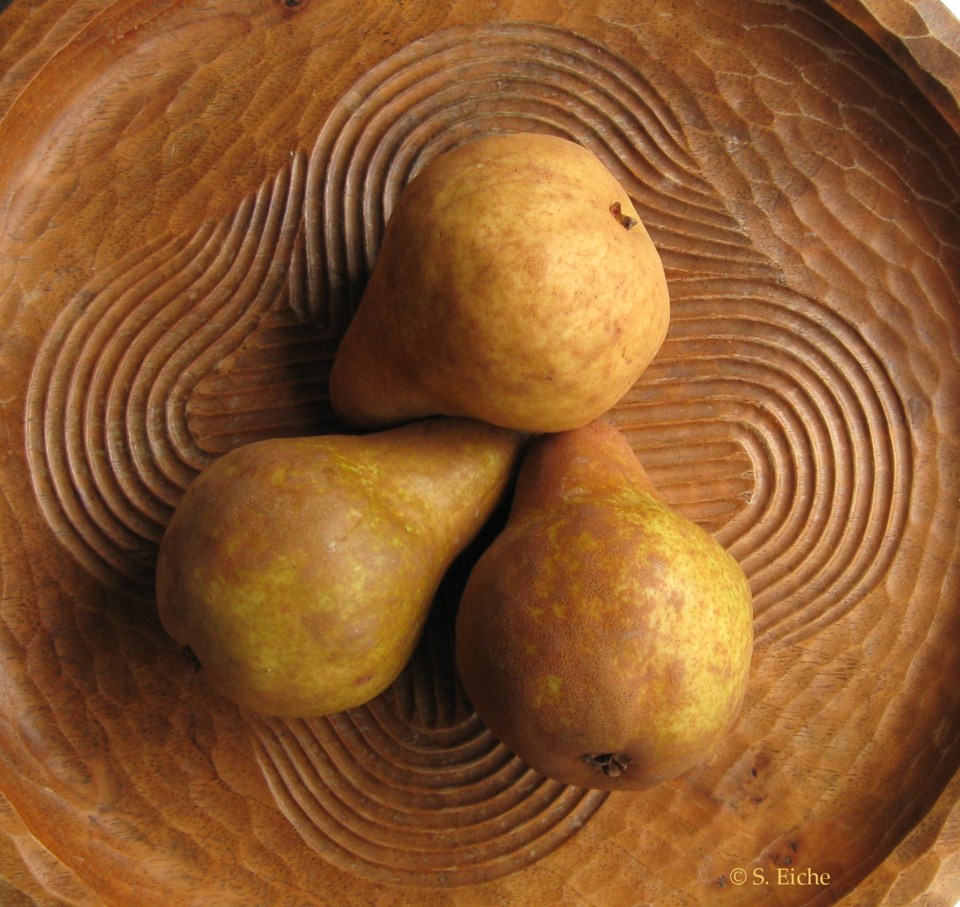Was 2022 a blue-ribbon year for pears in our region? It wouldn’t surprise me. Some weeks ago, at my favourite greengrocer, Sunshine Farms, on No.1 and Blundell, I saw a huge bin filled with Bartlett pears. A sign with the price identified them as local.
In the big chain supermarkets, pears often look not as if they’d grown on a tree, but as if they’d come out of a 3-D printer. The local pears I saw at the greengrocer looked as if they really had come from a tree. These were pears that started out as tiny bulbs, the size and shape of those miniature light bulbs that used to be in flashlights, and eventually reached their maturity a few months later.
I bought several of Sunshine Farms’ Bartletts to see what they were like. Never have I tasted better. Flavour and scent were intertwined in the flesh and juice of the fruit. I immediately bought more and passed the word to friends. When the Bartletts were all sold out, the bin was filled with local Bosc pears, followed by local D’Anjous.
Many years ago, I used to buy my pears and plums directly from an orchard at the south end of Shell Road. There I learned that pears need to mature (grow to their full size) on the tree, but would ripen after they’d been picked, because the pear ripens from the inside out. The way to test if the pear is ready to eat is to press it gently at the stem end — you should feel a slight give.
Pears are ranked as the least allergenic of all fruits and are therefore perfectly safe for anyone who suffers from food allergies. They are high in fibre and rich in potassium, vitamin C and phytochemicals (bioactive nutrient plant chemicals). If you read the labels on fruit juice blends (e.g. those of Ceres), you’ll find that pear juice is often a principal ingredient.
While pears are excellent consumed fresh they can also be canned, cooked and baked. For a few years now I’ve been making muffins with pears. For a dozen muffins I take one or two pears (depending on their size), peeled and cut into chunks. They become soft in the baking process and lend an incredible moistness to the muffins. This year I also began cooking pears with dried apricots (unsulfured), which produces a succulent compote. I cut the peeled pears into big chunks and the apricots into smaller pieces – the proportion of apricots to pears depends on your personal preferences. In a covered saucepan (without the addition of any liquid whatsoever) I let the pears and apricots ‘melt’ over the lowest possible heat. The time depends on the ripeness of the pears — I usually stop cooking when the juices of the pears and apricots have combined to make a light brown syrup. Delicious as a dessert, served with a dollop of yogurt or whipped cream, the compote can also be added to the breakfast muesli.
The name pear comes from the Latin “pira,” the plural of “pirum.” Pears have been cultivated since time immemorial in Europe, the Middle East, North Africa and Asia (it wasn’t until the early 17th century that they were introduced to North America). Pears are mentioned in the writings of ancient Greek and Roman authors. Often quoted is the phrase from Homer’s Odyssey (ninth century BC), where, in King Alcinous’s garden, Odysseus saw pears, pomegranates, apples, figs and olives, all “glorious gifts of the gods” (Book 7, lines 115 ff.).
It’s estimated that there are around 3,000 varieties of pears, and since some of the very oldest varieties are extinct, or heading there, attempts are being made to save as many as possible. An agronomist in Italy has had considerable success tracking down one particular ancient cultivar in Umbria, and her research tools include depictions of the pear by some of the still-life painters patronized by the Medici Grand Dukes of Tuscany.
Baroque art has many examples of paintings featuring pears, but perhaps the most memorable appearance of the pear in art is that provided in Tony Richardson’s 1963 film of Henry Fielding’s 18th century novel Tom Jones. In the scene of Tom and Mrs Waters devouring gargantuan amounts of meats and seafood, the meal ends with the two tucking into ripe, juicy pears, which I imagine would have tasted, in Fielding’s day, as divine as those I recently found at Sunshine Farms.
Sabine Eiche is a local writer and art historian with a PhD from Princeton University. She is passionately involved in preserving the environment and protecting nature. Her columns deal with a broad range of topics and often include the history (etymology) of words in order to shed extra light on the subject



